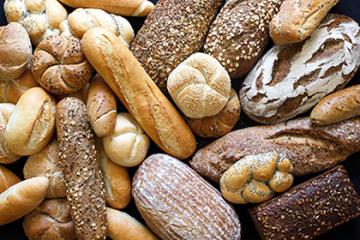Microbe Turns Bread Waste Into Useful Compound

ARS scientists found a way to make a valuable compound from bread waste. (Photo courtesy of Getty Images)
Food waste is a big problem, both practically and ethically. According to data from the U.S. Environmental Protection Agency, food accounted for more than 21 percent (63 million tons) of U.S. municipal waste in 2018. A significant portion of that waste comes from bread, rolls, and other baked goods. Some bread waste is fed to livestock as a source of carbohydrates and protein, but much of it gets tossed out.
The good news is that an Agricultural Research Service (ARS) team in Peoria, IL, found a way to use bacteria to convert the glucose (sugar) in bread waste into a compound known as 2KGA (2-keto-D-gluconic acid). In turn, 2KGA can be made into valuable compounds such as ascorbic acid (vitamin C), which is used in foods and beverages, supplements, and pharmaceutical and personal-care products.
The useful bacterium is Pseudomonas reptilivora.
In studies at the ARS National Center for Agricultural Utilization Research (NCAUR) in Peoria, team members Mark Berhow, Gregory Kennedy, Badal Saha, Karl Vermillion, and Sirma Yegin (Ege University, Turkey) devised fermentation procedures that encourage P. reptilivora to gobble up the glucose in bread waste and convert it into 2KGA.
According to Saha, a research chemist with the center's Bioenergy Research Unit, 2KGA is a "platform chemical" that helps synthesize bulk quantities of ascorbic acid, ascorbic acid salts, erythorbic acid, and other substances with food and industrial applications.
Other methods of generating 2KGA exist, but they require additives like nitrogen, mineral salts, and other costly ingredients. Once in a mixture of distilled water and enzymes, P. reptilivora can feast on glucose in bread waste, churning out 2KGA as it goes. With continued research and scale-up, the glucose-hungry bacteria may offer a biobased way to produce 2KGA—and simultaneously help tackle a food-waste issue.
The advance, which the team reported in a 2020 issue of Biomass Conversion and Biorefinery, is part of NCAUR's mission to develop new, value-added uses for agricultural commodities.
In this instance, the team's efforts began with a search of the center's ARS Culture Collection, which houses tens of thousands of microbial specimens from around the world. Many of these microbes are valued for their pharmaceutical, agricultural, industrial, and food uses. Originally added to the collection in the 1940s, P. reptilivora was once considered an unwelcome contaminant in fermentation procedures. Today the bacterium may earn respect as a renewable way to reduce food waste while generating a valuable product with many uses.—By Sue Kendall, ARS Office of Communications.

